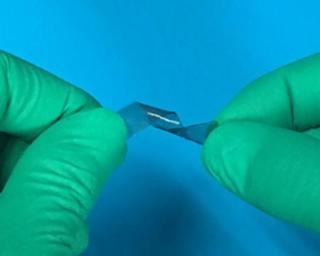Aug 21 2017
From smart socks to exercise clothes that calculate exertion, wearable body sensors are turning out to be the newest "must-have" technology. Currently, Researchers report they are close to using silk, one of the world's most desirable fabrics, to develop a more flexible and sensitive generation of these multi-purpose devices that monitor a number of body functions in real time.
 Silk could soon be used to produce more sensitive and flexible body sensors like this one. (Credit - Yingying Zhang)
Silk could soon be used to produce more sensitive and flexible body sensors like this one. (Credit - Yingying Zhang)
The Researchers will showcase their work at the 254th National Meeting & Exposition of the American Chemical Society (ACS). ACS, the largest scientific society in the world, is holding the meeting through this week. It features almost 9,400 presentations on a broad range of science topics.
There is a whole world of possibilities for silk sensors at the moment. Silk is the ideal material for fabricating sensors that are worn on the body. One possibility we foresee is for them to be used as an integrated wireless system that would allow doctors to more easily monitor patients remotely so that they can respond to their medical needs more rapidly than ever before.
Yingying Zhang, Ph.D.
Body sensors, which are typically composed of semiconductors, have displayed significant potential for monitoring human health. But they have limits. For example, strain sensors, which measure changes in force, cannot be extremely sensitive and very stretchable at the same time.
Silk, a natural material that is stronger than steel and more flexible than nylon, could overcome these issues. The fiber is also biocompatible and lightweight. However, silk does not conduct electricity properly. To resolve this hurdle, Zhang and colleagues at Tsinghua University in China aimed to find a way to increase the conductivity of silk so it could be productively used in body-sensing devices.
The Researchers planned to try two diverse strategies. In one method, they treated the silk in an inert gas environment with temperatures spanning from 1,112 °F to 5,432 °F. Consequently, the silk became infused with N-doped carbon with certain graphitized particles, which is electrically conductive. Using this method, the team has developed pressure sensors, strain sensors, and a dual-mode sensor that can measure temperature and pressure at the same time.
In the other method, the team fed either carbon nanotubes or graphene to silkworms. Some of these nanoparticles were naturally added into the silk formed by the worms. Thus far, this technique has not created electrically conductive fibers, but the Researchers continue experimenting with this method and are confident they can make it function.
Based on the groundwork results, Zhang is keen on exploring ways to develop an integrated set of silk-based, self-sustaining sensors that would be operated by nano-generators. She also proposes that her team's silk sensors might be used to construct more practical robots that can sense temperature, touch or humidity and can even differentiate between different people's voices.